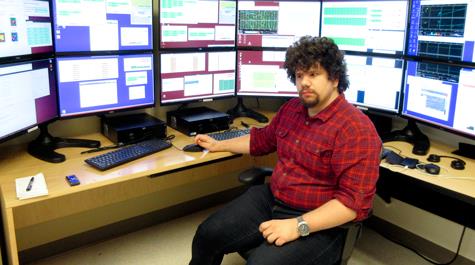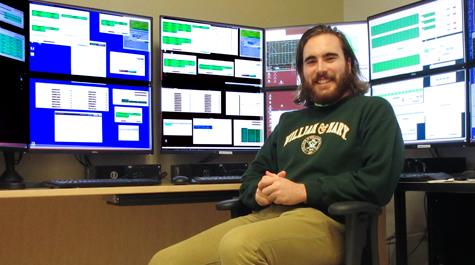A window on a world where cosmic rays are just background noise
Marco Colo waved a dismissive hand at a near-constant spatter of colorful streaks appearing across a screen monitoring action at the NOvA neutrino experiment.
“These aren’t neutrinos. Most of these things are just cosmic rays,” he explained, in the same weary tone that Han Solo used when he announced that mynocks had been chewing on the Millennium Falcon’s power cables. “You can tell by the downward trajectory.”
Neutrino physicists work in a world in which otherwise exotic phenomena such as cosmic rays are just background noise. The goal is to get a handle on large, important questions — such as how the universe began — through the understanding of the behavior of particles that can zoom through a brick of lead a light-year thick and that have a habit of shape-shifting in mid-flight.
Colo, a Ph.D. student in William & Mary’s Department of Physics, was in the middle of an eight-hour shift monitoring NOvA, which sends bazillions of these mysterious, super-abundant particles from a source at the Fermi National Accelerator Laboratory outside Chicago through the solid earth to a far detector 500 miles distant near Ash River, Minnesota.
William & Mary has a number of physicists who collaborate on NOvA, as well as other neutrino experiments across the world. Now, members of William & Mary’s NOvA team don’t have to go to Fermilab to do their part. They can stand their shifts right from the third floor of Small Hall.
The NOvA remote control facility was funded from Patricia Vahle’s CAREER grant from the National Science Foundation. A testing and calibration period was followed by a set of “shadow shifts,” explained Vahle, associate professor of physics. The shadow shifts are like driver’s training lessons for physicists, she said, as the William & Mary physicists are being monitored by Fermilab personnel until the Small Hall facility and individuals using it all become certified.
Like his fellow NOvA physicists, Colo pulls his shift in a room dominated by a dozen largish computer monitors. Each monitor tracks different aspects of the NOvA experiment. The most important monitors are the ones that show the beam status, the neutrinos passing through the near detector and the far detector — the panel usually dominated by cosmic rays.
“We make a beam of neutrinos at Fermilab,” Vahle explained. “And we monitor that beam right up close — that’s the near detector. We measure that same beam of neutrinos many hundreds of miles away, up in northern Minnesota. We can compare our measurements in the two locations.”
{{youtube:medium:left|Fe4veClYxkE, Exploring Neutrino Mysteries}}
Differences in the two measurements can help physicists solve the puzzle of neutrino oscillation — the scientist’s term for the neutrino’s shape-shifting among three different states, or “flavors.”
“We say that we make chocolate ice cream at Fermilab,” Vahle said. “And by the time it gets up to northern Minnesota, it’s changed to strawberry. There’s no more chocolate ice cream. That’s neutrino oscillation, and that’s what we’re trying to measure.”
NOvA and other experiments are collecting data that will one day yield an explanation of the physical laws governing oscillation and other neutrino phenomena. Neutrinos themselves are produced by the sun’s fusion furnace (and also by all other stars). Nuclear power plants emit neutrinos. Neutrinos produced by the Big Bang more than 13 billion years ago are still zooming through matter as if it wasn’t there.
Because they are so numerous and ubiquitous, scientists believe that an understanding of neutrino physics can not only tell us a lot about the beginning of the universe, but also might give us clues about its ultimate end. Neutrino science also offers potential for the development of less cosmic, but quite important, applications such as apparatus to detect nuclear weapons activity.
Until the remote control facility came on line, each of the NOvA collaborators at William & Mary would spend three days to a week at Fermilab. In addition to Vahle and Colo, current collaborators include postdoc Alexander Radovic, Ph.D. student Ji Liu and Jeffrey Nelson, a professor of physics.
“Hopefully, this will save each of us two trips to Fermilab a year,” Vahle said.
The physicists have involved a number of undergraduates in NOvA as well, notably Jack Donahue ’17. Donahue asked to get involved in the project following a summer Research Experience for Undergraduates experience with the physics department. Vahle put him to work on the control room project, which proved to be more challenging than a simple hookup.
“I had never used Linux computers before. And the software to make it work was for a slightly different system. So I had to adapt it to work with our machines, which took a while, and there was a lot of banging my head against the table,” Donahue said.
He worked the last bugs out of the hookup to Fermilab in late October.
“I was sitting in Swem and it finally worked on the little laptop that I was testing things out on,” Donahue said. “I stood up and cheered, because it took so long to get working.”
Immense apparatus are required to detect neutrinos, as the particles rarely interact with matter. The NOvA far detector in Minnesota is the largest plastic structure on earth, purpose-built to detect just a few of the stream of neutrinos flying through the solid earth at near-light speed from the beam source at Fermilab, oscillating as they go.
Colo says that an average eight-hour shift records a single neutrino event among the hail of cosmic rays at the far detector.
“You never see it, though!” Vahle said. The neutrinos, maintaining their reputation for elusiveness, she said, seem to have a way of popping up when you’re looking at one of the other 11 NOvA monitors.
 Skip to main content
Skip to main content


